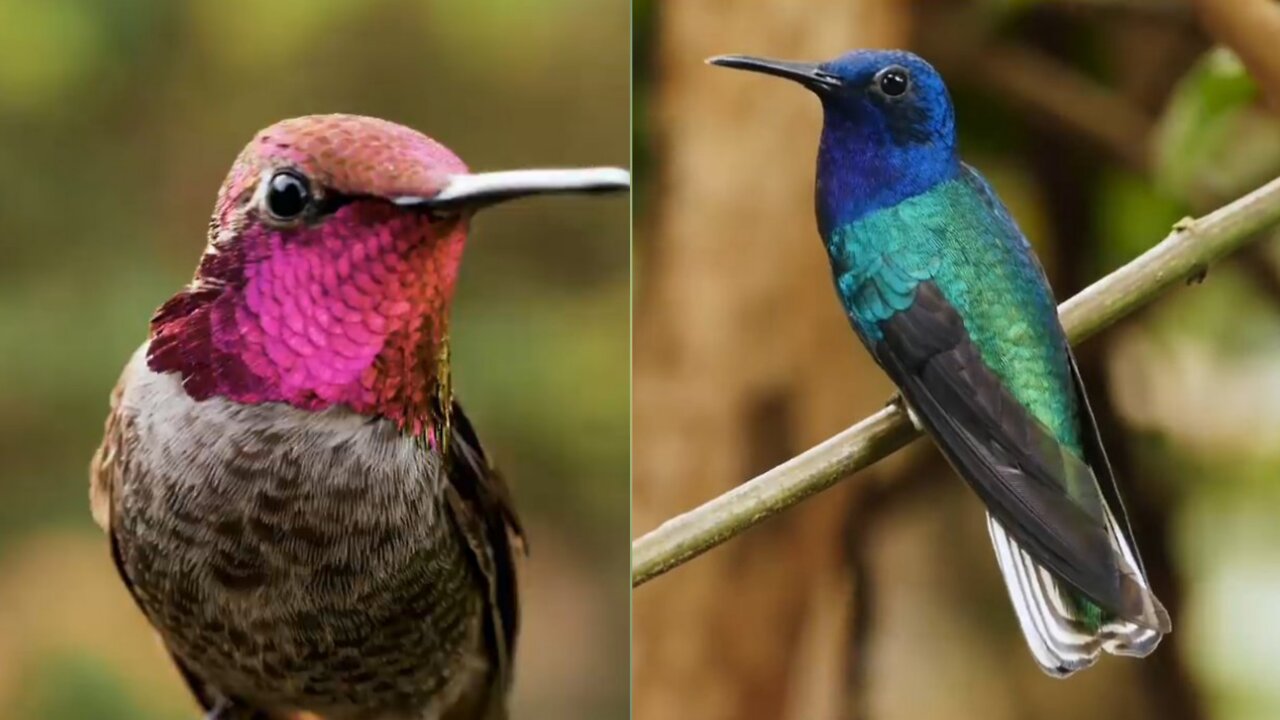Premium Only Content

birds,animals, discovery animals videos |
birds,animals, discovery animals videos |
Birds are vertebrates (animals with backbones) with wings and feathers. Most birds can fly, using powerful muscles to flap their wings. But a few bird species do not have strong enough wings to fly, and so these birds are flightless.
bird, (class Aves), any of the more than 10,400 living species unique in having feathers, the major characteristic that distinguishes them from all other animals. A more-elaborate definition would note that they are warm-blooded vertebrates more related to reptiles than to mammals and that they have a four-chambered heart (as do mammals), forelimbs modified into wings (a trait shared with bats), a hard-shelled egg, and keen vision, the major sense they rely on for information about the environment. Their sense of smell is not highly developed, and auditory range is limited. Most birds are diurnal in habit. More than 1,000 extinct species have been identified from fossil remains.
Since earliest times birds have been not only a material but also a cultural resource. Bird figures were created by prehistoric humans in the Lascaux Grotto of France and have featured prominently in the mythology and literature of societies throughout the world. Long before ornithology was practiced as a science, interest in birds and the knowledge of them found expression in conversation and stories, which then crystallized into the records of general culture. Ancient Egyptian hieroglyphs and paintings, for example, include bird figures. The Bible refers to Noah’s use of the raven and dove to bring him information about the proverbial Flood.
Various bird attributes, real or imagined, have led to their symbolic use in language as in art. Aesop’s fables abound in bird characters. The Physiologus and its descendants, the bestiaries of the Middle Ages, contain moralistic writings that use birds as symbols for conveying ideas but indicate little knowledge of the birds themselves. Supernatural beliefs about birds probably took hold as early as recognition of the fact that some birds were good to eat. Australian Aborigines, for example, drove the black-and-white flycatcher from camp, lest it overhear conversation and carry the tales to enemies. Peoples of the Pacific Islands saw frigate birds as symbols of the Sun and as carriers of omens and frequently portrayed them in their art. The raven—a common symbol of dark prophecy—was the most important creature to the Indians of the Pacific Northwest and was immortalized in Edgar Allan Poe’s poem “The Raven.” Eagles have long been symbols of power and prestige in many parts of the world, including Europe, where their representations are often seen in heraldry. Native Americans sprinkled eagle down before guests as a sign of peace and friendship, and eagle feathers were commonly used in rituals and headdresses. The resplendent quetzal—the national bird of Guatemala, which shares its name with the currency and is a popular motif in art, fabric, and jewelry—was worshipped and deified by the ancient Mayans and Aztecs. Highly symbolic birds include the phoenix, representing resurrection, and the owl, a common symbol of wisdom but also a reminder of death in Native American mythology. The bird in general has long been a common Christian symbol of the transcendent soul, and in medieval iconography a bird entangled in foliage symbolized the soul embroiled in the materialism of the secular world.
Birds arose as warm-blooded, arboreal, flying creatures with forelimbs adapted for flight and hind limbs for perching. This basic plan has become so modified during the course of evolution that in some forms it is difficult to recognize.
Among flying birds, the wandering albatross has the greatest wingspan, up to 3.5 metres (11.5 feet), and the trumpeter swan perhaps the greatest weight, 17 kg (37 pounds). In the largest flying birds, part of the bone is replaced by air cavities (pneumatic skeletons) because the maximum size attainable by flying birds is limited by the fact that wing area varies as the square of linear proportions, and weight or volume as the cube. During the Pleistocene Epoch (2.6 million to 11,700 years ago) lived a bird called Teratornis incredibilis. Though similar to the condors of today, it had a larger estimated wingspan of about 5 metres (16.5 feet) and was by far the largest known flying bird.
-
 LIVE
LIVE
TheAlecLaceShow
12 hours agoGuests: Rep. Scott Perry | Jason & Erica Redman | Dems Want Government Shutdown | The Alec Lace Show
152 watching -
 52:21
52:21
The Rubin Report
2 hours ago‘Shark Tank’ Legend Notices Something About Trump’s Canada Plan No One Noticed
64.4K38 -
 1:39:07
1:39:07
Benny Johnson
2 hours agoPANIC: Massive Democrat Money Laundering Scandal EXPOSED, ActBlue in Collapse! Kash Criminal Charges
73.4K67 -
 2:08:37
2:08:37
Steven Crowder
4 hours agoUSAID Shredding Conspiracy | What Everyone's Getting Wrong with Half Asian Lawyer Bill Richmond
295K191 -
 1:07:01
1:07:01
Timcast
3 hours agoTrump THREATENS MASSIVE 200% Tariff Against EU As GLOBAL Trade War IGNITES, China Hits Canada
64.1K80 -
 LIVE
LIVE
Flyover Conservatives
12 hours agoNew Documentary Reveals Life-Threatening Corruption in the U.S. Government! - Matt Thayer; Michelle Obama & Gavin Newsom Enter the Podcast Game—But Why Now?| FOC Show
649 watching -
 2:03:11
2:03:11
LFA TV
17 hours agoCORNERED RATS RETALIATE! | LIVE FROM AMERICA 3.13.25 11AM
44.7K11 -
 48:29
48:29
BonginoReport
5 hours agoSatanists Dedicate Kansas Capitol to Satan (Ep.159) - 03/13/2025
127K176 -
 2:07:09
2:07:09
Matt Kohrs
15 hours agoBreaking Market News: Tariffs, Inflation & Gov'nt Shutdown || The MK Show
67.4K4 -
 2:59:43
2:59:43
Wendy Bell Radio
9 hours agoThe Schumer Shutdown
126K44